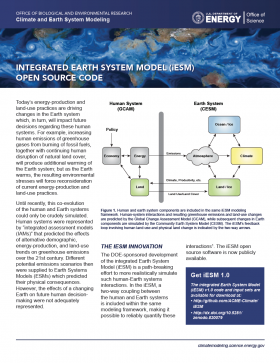Integrated Earth System Model (iESM) Open Source Code
Today’s energy-production and land-use practices are driving changes in the Earth system which, in turn, will impact future decisions regarding these human systems. For example, increasing human emissions of greenhouse gases from the burning of fossil fuels, together with continuing human disruption of natural land cover, will produce additional warming of the Earth system; but as the Earth warms, the resulting environmental stresses will force reconsideration of current energy-production and land-use practices.
Until recently, this co-evolution of the human and Earth systems could only be crudely simulated. Human systems were represented by “integrated assessment models (IAMs)” that predicted the effects of alternative demographic, energy-production, and land-use trends on greenhouse emissions over the 21st century. Different potential emissions scenarios then were supplied to Earth Systems Models (ESMs) which predicted their physical consequences. However, the effects of a changing Earth on future human decisionmaking were not adequately represented.
The DOE-sponsored development of the integrated Earth System Model (iESM) is a path-breaking effort to more realistically simulate such human-Earth systems interactions. In the iESM, a two-way coupling between the human and Earth systems is included within the same modeling framework, making it possible to reliably quantify these interactions. The iESM open source software is now publicly available.


